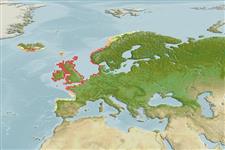Common names from other countries
Classification / Names / Names
Namen | Synonyme | Catalog of Fishes (gen., sp.) | ITIS | CoL | WoRMS
Environment: milieu / climate zone / depth range / distribution range
Ökologie
; brackwasser; tiefenbereich 7 - 9 m (Ref. 2851). Temperate
Northeast Atlantic: Europe.
Length at first maturity / Size / Gewicht / Alter
Maturity: Lm ? range ? - ? cmmax. veröff. Alter: 1.00 Jahre (Ref. 130103)
Depth based on occurrence (Ref. 2851, p. 719); to be replaced with better reference. Life span is less than 1 yr (Ref. 130103). Found in estuarine and inshore areas in silt to very fine sand substrate. A microvore that feeds on organic detritus (Ref. 96352).
Life cycle and mating behavior
Geschlechtsreife | Fortpflanzung | Ablaichen | Eier | Fecundity | Larven
Members of the order Cumacea are gonochoric and sexually dimorphic. Spawning is characterized by nocturnal swarming behavior. Females brood the eggs in the marsupium where they molt, become mancas and leave.
Alves, F., L. Chicharo, A. Nogueira and J. Regala. 2003. (Ref. 2851)
IUCN Rote Liste Status (Ref. 130435)
CITES Status (Ref. 108899)
Not Evaluated
Not Evaluated
Nutzung durch Menschen
| FishSource |
Tools
Mehr Information
Alter/GrößeWachstumLänge-GewichtLänge-LängeMorphologieLarvenDichte
Internet Quellen
Estimates based on models
Preferred temperature
(Ref.
115969): 8.9 - 12.5, mean 10.7 (based on 314 cells).
Widerstandsfähigkeit
hoch, Verdopplung der Population dauert weniger als 15 Monate. (tmax<1).
Preiskategorie
Unknown.
